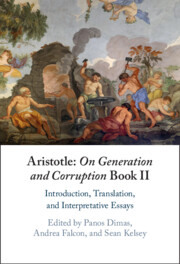 Aristotle: On Generation and Corruption Book II
Aristotle: On Generation and Corruption Book II Book contents
- Aristotle: On Generation and Corruption Book II
- Aristotle: On Generation and Corruption Book II
- Copyright page
- Contents
- Figures
- Tables
- Notes on Contributors
- Preface
- Abbreviations
- Part I Introduction and Interpretative Essays
- 1 On Generation and Corruption II
- 2 On Generation and Corruption II 1
- 3 On Generation and Corruption II 2
- 4 On Generation and Corruption II 3
- 5 On Generation and Corruption II 4
- 6 On Generation and Corruption II 5
- 7 On Generation and Corruption II 6
- 8 On Generation and Corruption II 7
- 9 On Generation and Corruption II 8
- 10 On Generation and Corruption II 9
- 11 On Generation and Corruption II 10
- 12 On Generation and Corruption II 11
- Part II Translation
- References
- Subject Index
- Index of Passages
8 - On Generation and Corruption II 7
from Part I - Introduction and Interpretative Essays
Published online by Cambridge University Press: 10 November 2022
- Aristotle: On Generation and Corruption Book II
- Aristotle: On Generation and Corruption Book II
- Copyright page
- Contents
- Figures
- Tables
- Notes on Contributors
- Preface
- Abbreviations
- Part I Introduction and Interpretative Essays
- 1 On Generation and Corruption II
- 2 On Generation and Corruption II 1
- 3 On Generation and Corruption II 2
- 4 On Generation and Corruption II 3
- 5 On Generation and Corruption II 4
- 6 On Generation and Corruption II 5
- 7 On Generation and Corruption II 6
- 8 On Generation and Corruption II 7
- 9 On Generation and Corruption II 8
- 10 On Generation and Corruption II 9
- 11 On Generation and Corruption II 10
- 12 On Generation and Corruption II 11
- Part II Translation
- References
- Subject Index
- Index of Passages
Summary
GC II 7 supports Aristotle’s elemental theory, according to which the four elements possess a common matter that enables their inter-transformation, over the superficially similar Empedoclean one, by arguing that the former theory, and it alone, can accommodate the formation of homogenous stuffs like flesh and bone from the four elements. According to the interpretation offered here, these stuffs are mixtures in the sense spelled out in GC II 10, and appear to be exhibit the kind of strong uniformity that some interpreters have denied to Aristotelian mixtures. Special attention is devoted to bringing out the significance of elemental mixture for Aristotle’s twin projects in GC: understanding the causes of generation and destruction and establishing a theory of the elements. Explaining the formation of elemental mixtures is a crucial step in showing how the generation of more complex substances is possible and how the four elements, as he conceives them, function as elements of more complex substances.
- Type
- Chapter
- Information
- Aristotle: On Generation and Corruption Book IIIntroduction, Translation, and Interpretative Essays, pp. 151 - 177Publisher: Cambridge University PressPrint publication year: 2022
